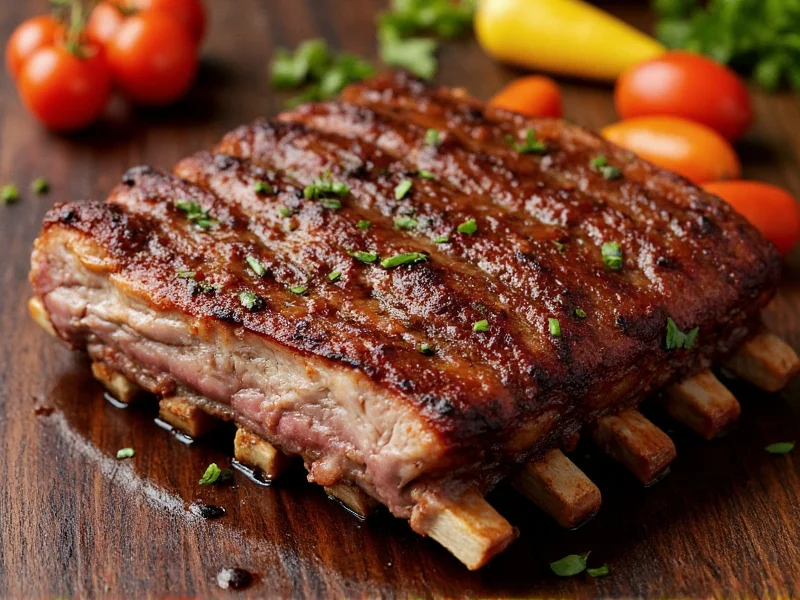When you see “short ribs” on a menu or at your local butcher, you're looking at a beef cut. This common point of confusion arises because both pork and beef have rib sections, but butchers use distinct terminology for each. Understanding this difference matters for cooking, shopping, and menu selection.
What Exactly Are Short Ribs?
Short ribs come from the plate section (lower rib cage) of cattle, below the back ribs. Butchers cut them “short” because they're separated between the bones, creating shorter sections than traditional rib cuts. This yields meaty portions with substantial bone, fat, and collagen that transform beautifully during slow cooking.
The confusion with pork stems from the fact that pork has its own rib categories—baby back ribs, spare ribs, and St. Louis-style ribs—but these are never labeled as “short ribs.” Short ribs exclusively refer to the beef cut, though some specialty butchers might offer “pork short ribs” (actually rib tips), which are uncommon.
Why People Confuse Short Ribs as Pork
Several factors contribute to the “is short ribs pork or beef” confusion:
| Confusion Source | Explanation |
|---|---|
| Similar cooking methods | Both pork ribs and beef short ribs benefit from slow, moist cooking techniques like braising |
| Menu terminology | Some restaurants list “ribs” without specifying beef or pork |
| Butcher labeling | Improperly labeled meat at grocery stores can mislead shoppers |
| Regional variations | Certain areas use non-standard terms for meat cuts |
Identifying Authentic Beef Short Ribs
When shopping for short ribs, look for these characteristics:
- Bone structure: Rectangular bones 3-4 inches long with substantial meat on top
- Marbling: Visible fat streaks throughout the meat (essential for flavor)
- Cut style: English cut (bones separated), flanken cut (thin slices across bones), or boneless
- Color: Deep red meat with creamy white fat (avoid grayish meat)
Pork ribs display different features—smaller bones, leaner meat, and less marbling. Baby back pork ribs curve noticeably, while spare ribs have more bone and less meat. Neither resembles true short ribs.
Cooking Short Ribs: Why Beef Reigns Supreme
The reason short ribs are exclusively a beef cut lies in their culinary application. Beef short ribs contain abundant collagen that melts during slow cooking, creating fork-tender meat with unmatched richness. This transformation makes them ideal for:
- Korean galbi (flanken-cut short ribs)
- French pot-au-feu
- Barbecue smoked preparations
- Braised dishes like Italian ossobuco (though ossobuco uses shank)
Pork ribs lack the same collagen structure and fat distribution, making them unsuitable for traditional short rib recipes. Attempting to substitute pork would yield dry, stringy results without the characteristic unctuous texture.
Shopping Tips for Short Ribs
When purchasing beef short ribs:
- Ask for the plate cut specifically—this ensures you get authentic short ribs
- Check thickness—ideal portions have 1-1.5 inches of meat atop the bone
- Consider cooking method—English cut for braising, flanken for grilling
- Price wisely—expect to pay $8-$15 per pound depending on quality
Avoid packages labeled simply “ribs” without meat specification. Reputable butchers will clarify whether they're offering beef short ribs or pork rib varieties. If shopping online, look for “beef short ribs” in the product description to avoid confusion.
Common Substitutes When Short Ribs Are Unavailable
If you can't find short ribs but need a similar cooking experience:
- Brisket—similar collagen content for braising
- Oxtail—provides comparable gelatinous texture
- Chuck roast—more affordable but less bone-in flavor
Never substitute pork ribs for beef short ribs in recipes calling for the latter—the flavor profile and cooking behavior differ significantly. The question “is short ribs pork or beef” matters because using the wrong meat fundamentally changes the dish.
Final Clarification: Short Ribs Are Beef
To reiterate the core answer to “is short ribs pork or beef”—short ribs are unequivocally a beef cut. While pork has various rib options, the term “short ribs” specifically denotes the lower rib section of cattle. This distinction affects everything from cooking times to flavor development and final dish quality.
Understanding this difference helps you make informed choices whether you're ordering at a restaurant, shopping at the market, or following a recipe. Next time you encounter short ribs, you'll know exactly what meat you're working with and how to maximize its potential.
Are short ribs always beef?
Yes, authentic short ribs are exclusively a beef cut from the plate section of cattle. While some specialty butchers might offer pork rib tips labeled as “pork short ribs,” this is non-standard terminology. When recipes or menus mention “short ribs” without specification, they always refer to beef.
Why are they called short ribs if they're beef?
They're called “short” because butchers cut them “short” across the bone, creating shorter sections than traditional rib cuts. This distinguishes them from back ribs (longer sections with less meat) and refers specifically to the beef plate cut, not pork ribs.
Can I substitute pork ribs for short ribs in recipes?
No, pork ribs make a poor substitute for beef short ribs. They have different fat composition, collagen structure, and flavor profiles. Pork ribs cook faster and become dry if prepared using short rib methods. For similar results, use brisket or chuck roast instead of pork.
What's the difference between short ribs and regular ribs?
Regular “back ribs” come from higher on the rib cage with less meat and more bone, while short ribs come from the plate section (lower ribs) with substantial meat, fat, and connective tissue. Short ribs require longer cooking times to break down collagen, yielding richer, more tender results than back ribs.
How do I know if I'm getting real short ribs at the store?
Look for rectangular bones 3-4 inches long with 1-1.5 inches of meat on top, significant marbling, and deep red color. Ask your butcher specifically for “beef short ribs from the plate cut.” Avoid packages labeled only “ribs” without meat specification, as these could be pork.











 浙公网安备
33010002000092号
浙公网安备
33010002000092号 浙B2-20120091-4
浙B2-20120091-4